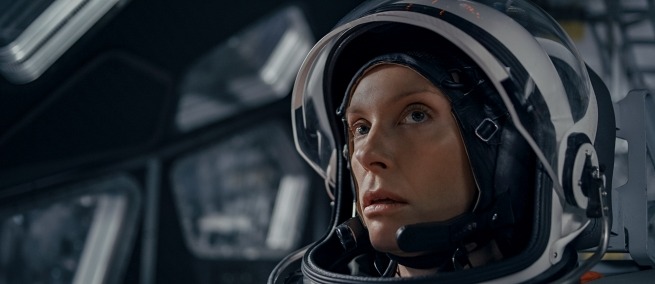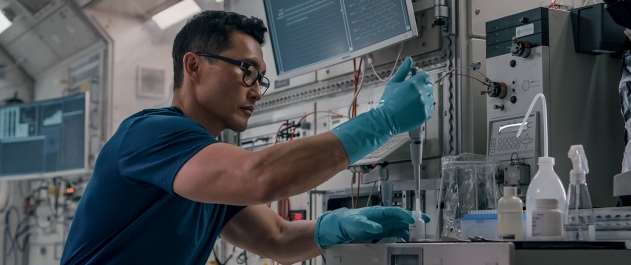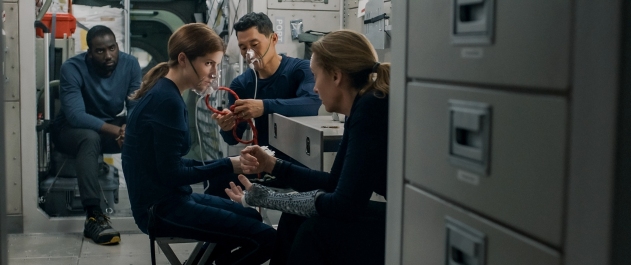
STOWAWAY, a new sci-fi film on Netflix, is not the typical space thriller—there are no aliens or lightspeed ships. Rather, the film finds its dramatic tension in the dynamics of three astronauts (played by Toni Collette, Anna Kendrick, and Daniel Dae Kim) and one stowaway (Shamier Anderson) whose presence upends their planned two-year journey to Mars. We spoke with the film’s writer/director Joe Penna and his co-writer Ryan Morrison about the working with NASA scientists on the production, how to make a space film on a budget, and simulating microgravity.
Science & Film: Why were you looking for drama in what some might consider the mundane elements of a space mission?
Joe Penna: We felt like we had seen a lot of the different tropes done so well and we wanted to try something different.
Ryan Morrison: One of the challenges we wanted to tackle was to take a philosophical situation that a lot of people are familiar with and put a few scientists and engineers together to see what four intelligent people would do when no one has ill intent. Partly, we were trying to have astronauts watch this and say, that might be something I would do.
We are both space enthusiasts and with our cursory knowledge before writing STOWAWAY, we would watch some science fiction films and say, if I know that’s wrong, pretty sure everyone knows there’s something off. Our approach from the very beginning was to create a film that’s as scientifically accurate as possible and it carries through to the entirety [of the film]—the production design, acting, editing, color of the film, and into the viewer as well.

Daniel Dae Kim in STOWAWAY, courtesy of Netflix.
S&F: Did you work with any scientists as consultants on the writing or production design?
RM: Yes, we had the great fortune of working with the Science & Entertainment Exchange and met some incredible engineers and scientists. We spoke with them very early in the process of coming up with this concept so that we could create a situation that was informed by reality. Some of the equipment and the technical obstacles that we offered our characters, we actually spoke with people who helped engineer them. They told us, this could break, and this is what we would use for back-up. It was a thrill to be able to work with those experts and professionals.
JP: We would basically cold call and cold email everyone we could. We’d look up something like the thing that scrubs carbon dioxide from the International Space Station, then we’d look up a white paper or research paper, then find that author’s email, and then they would say, what you’re doing is close and here’s how to fix it. Then when we were on set, we would Facetime with them, or they would be on set saying that the algae should be greener, or to make that button red.
We would also go to museums and tell them that we were making a film that was really accurate and ask if they had anything that had flown to space, and they’d let us borrow it. Of course, they’d be reluctant at first, but once we showed them our script and pictures of what we had built, they said, just bring it back the way it was.
RM: We were really fortunate too with our production designers, they were incredibly authentic, really inspired by the International Space Station. Some folks at the JPL helped us produce our artificial gravity. That science hasn’t quite been done yet, but the theory is there. We essentially built what they hope to build. It was a nice look five minutes into the future through the eyes of legitimate engineers and scientists.

The cast of STOWAWAY, courtesy of Netflix.
S&F: It sounds like everyone was pretty receptive to the pitch of helping on the film, is that right?
RM: Yeah, they were very receptive, and a lot of them said: here is a ten-page explanation of what would actually happen, but I understand that it’s movie.
S&F: I do feel like there is more awareness in both the sciences and general public about the way that science is represented in film.
JP: That was actually a challenge for us while shooting, especially in the micro gravity and zero gravity scenes: we needed to figure out a way to trick the audiences. That’s really hard when everyone’s watched how Christopher Nolan does it, and how all of these huge films with massive budgets to do what we were trying to do with not even a tenth of what they had. We had a different trick for every single shot of the film: one time, you’re hanging the actors from wires; the next time it’s fully CG; the time after that there’s a huge screen in the background that is showing the stars spinning.
S&F: How did you work with Toni Collette on her portrayal of a mission leader and engineer?
JP: She had a really clear idea of who this commander was going to be from the very beginning. One of the first things she said was, I’d be afraid that this character was too wooden if I just read [your script], but since I watched your film ARCTIC where you were able to pull so much emotion out of a character with fewer lines, I think I’m in good hands. We’d just watched a Toni Collette film and we knew right away she was going to be our commander.
RM: It was really interesting watching Toni bring that character to life because she represents the seesaw that the audience is on; she’s stuck in the middle and she’s the one with the power of making the decision. She brought such human elements to a person who is stuck in an impossible position.
STOWAWAY is now available to watch on Netflix.
TOPICS